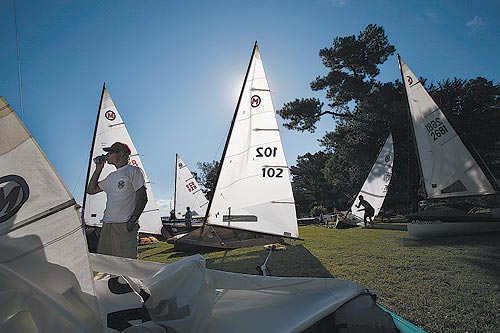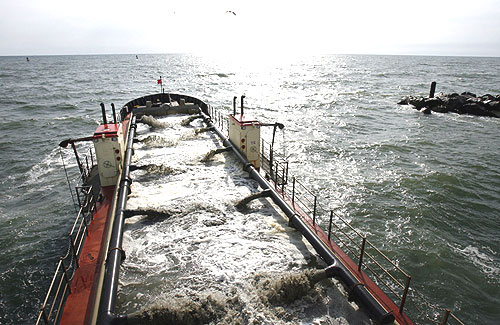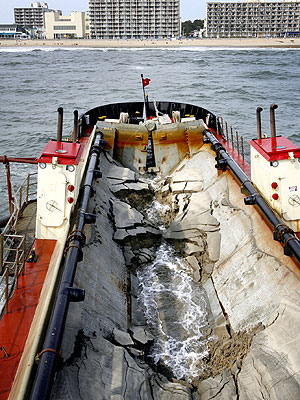'Lost Colony' search goes on centuries later By Mike Baker, Associated Press
GREAT DISMAL SWAMP, N.C. — After trudging for two hours through thick vegetation to a blurry mark found on Google Earth, George Ray started making up a song: "If you're lost, I'll find you tomorrow," he sang in a thick Southern drawl.
Or, perhaps, he'll find you four centuries later.
Ray is one of the many amateur archaeologists entranced by the Lost Colony — the 117 English settlers who disappeared from North Carolina's Outer Banks in the late 1500s, having left behind only a single clue to their fate. In all the years since, no one has found much of anything else.
But there have long been stories told about a rotting boat in the Great Dismal Swamp, a national wildlife refuge that straddles North Carolina's border with Virginia. Ray's colleagues think the colonists may have passed through the swamp after leaving Roanoke Island. They studied satellite images until they found something that looked like a boat, then set out to find it.
"We're not looking for gold," Ray said. "We're looking for history."
But the search for the Lost Colony has confounded experts and enthusiasts alike.
Eric Klingelhofer, a Mercer University professor, is an archaeologist with a doctorate from Johns Hopkins. He helped uncover the English colony at Jamestown, Va., and is working with the National Park Service to conduct digs on Roanoke Island.
"This is one of the hardest archaeological puzzles imaginable," said Klingelhofer, who serves as vice president of the First Colony Foundation, a research team of archaeologists and historians founded three years ago to dig at Fort Raleigh on Roanoke Island.
Ray is a retired home builder from Durham who got his start as a member of the Lost Colony Center for Science and Research, a group comprised mostly of amateurs pursuing a variety of theories: that the colony left Roanoke Island for the southern Outer Banks, or North Carolina's interior, or Virginia via the swamp.
Though The Lost Colony Center has consulted with academics and experts, other observers dismiss their work, which is published primarily on a blog instead of a peer-reviewed academic journal.
"I fear that they are only out looking for publicity," said Charles Ewen, who heads the Department of Anthropology at East Carolina University.
Perhaps, but no one with a degree and university tenure has been able to figure out exactly what happened to the Lost Colony, either.
Here's what's known: In 1585, English explorer Ralph Lane landed on the Outer Banks with a crew of 75 men, writing upon his arrival that they had come upon the "goodliest soyle under the cope of heaven."
The enchantment didn't last. The "First Colony" fought with natives, and food supplies quickly dwindled. They sent a party back to England seeking fresh supplies, but didn't wait for their return. Instead, they hitched a ride back home with Sir Francis Drake, who was passing through after raiding Spanish ports in the Caribbean.
When the men with relief supplies arrived to find the colony abandoned, they left a detachment of about 15 and sailed themselves for England.
Undeterred by the chaos, Sir Walter Raleigh sent John White and a new group of settlers one year later to pick up the so-called "holding colony" and to found a new settlement in what is now Virginia. White was unable to find the men left behind, and Indians reported that other natives had attacked the group and forced them to flee by boat.
Concerned about their own future and plagued by a lack of food, the colonists persuaded White to return to England for help. He agreed, leaving behind 116 colonists and his newborn granddaughter Virginia Dare — the first English child born in the New World. The colonists promised White they would carve a Maltese cross into a tree if they encountered turmoil and were forced to flee.
White made it back to England, but was delayed for three years by war between Spain and England. When he returned in 1590, he found no trace of the colonists he left behind, aside from the post and the word "Croatoan."
Some researchers speculate the Lost Colony could have assimilated with the Croatan tribe, which lived to the south near Cape Hatteras and is now considered part of the Lumbee tribe that lives in the sandhills of North Carolina.
Others have suggested the colonists moved farther inland and joined with other American Indians. Some suspect the natives simply killed the foreigners, or that the colonists died off from illness, malnutrition or in flight back to England.
Fred Willard, the director of the Lost Colony Center for Science and Research, called the colony "the greatest unsolved mystery in the Americas."
"And the things we're finding could rewrite history books," he said.
It took six months for volunteers working with The Lost Colony Center to win permission from the U.S. Fish and Wildlife Service to explore the Great Dismal Swamp. When they arrived, guided by GPS equipment and escorted by a pair of refuge officers, they found no conclusive answers.
In a mucky marsh, there was some partially buried wood that faintly — with the benefit of an active imagination — resembled the outline of an 80-foot-long boat. There were no other clues, such as the copper-sheathed hull common on seafaring vessels of Lost Colony's time, and none of the three searchers had a scientific background or expertise to conclude much of anything.
Ray was convinced they'd found something. His son, Frank, wasn't as certain.
"There's no boarding ladder here, that's for sure," Frank Ray said. "You start with theory. This is a starting point. You're not convinced until you get proof."
Proof will have to wait for another venture into the swamp. The wildlife service refused to let the group probe the ground, dig for clues, or even take a wood sample for carbon dating. That will require a different permit.
"Anything seems plausible, but we can't be sure until we can do more than just walk in and look," Frank Ray said. Both Rays have split with The Lost Colony Center since their trip into the swamp, and are now pursuing their research on their own.
A Fort Raleigh archaeological dig led by veteran researcher Ivor Noel Hume in the early 1990s turned up the remnants of a scientific workshop — dating to the abandoned attempt at colonizing Roanoke two years prior to the Lost Colony — but didn't uncover the colonists' living area. In 1998, an archaeological dig led by East Carolina University on Hatteras Island turned up a signet ring that may have ties to English colonists.
The First Colony Foundation plans to use ground-penetrating radar to search for artifacts or structures at Roanoke Island. The group also plans to survey the shoreline to determine how it has eroded. Divers have already checked offshore areas, and researchers believe Fort Raleigh's original site may be buried under water or eroded away altogether. If that's the case, little would have been left behind to prove any theories about the colony's fate.
"Every theory is probably partially true. Every theory is, however, significantly wrong," said Phil Evans, president of the First Colony Foundation. "Everybody wants one answer, but the reality is that you're looking to determine the fate of 117 different individuals."
Copyright 2007 The Associated Press. All rights reserved. This material may not be published, broadcast, rewritten or redistributed.
Blogged with Flock











